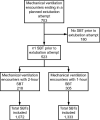Pediatric Ventilator Liberation: One-Hour Versus Two-Hour Spontaneous Breathing Trials in a Single Center
- PMID: 37015811
- PMCID: PMC10171336
- DOI: 10.4187/respcare.10652
Pediatric Ventilator Liberation: One-Hour Versus Two-Hour Spontaneous Breathing Trials in a Single Center
Abstract
Background: The optimal spontaneous breathing trial (SBT) duration is not known for children who are critically ill. The study objective was to evaluate extubation outcomes between cohorts exposed to a 1- or 2-h SBT.
Methods: This was a retrospective cohort study of a quality improvement project database in a 24-bed pediatric ICU. The intervention was a respiratory therapist-driven SBT clinical pathway across 2 improvement cycles by using a 2- or 1-h SBT. The primary outcomes were extubation failure and rescue noninvasive ventilation in the first 48 h. Secondary outcomes included SBT results and process measures.
Results: There were 218 and 305 encounters in the 2- and 1-h cohorts, respectively. Extubation failure (7.3 vs 8.5%; P = .62) and rescue noninvasive ventilation rates (9.3 vs 8.2%; P = .68) were similar. In logistic regression models, SBT duration was not independently associated with either primary outcome. Extubation after 1-h SBT failure was associated with significantly higher odds of rescue noninvasive ventilation exposure (odds ratio 3.94, 95% CI 1.3-11.9; P = .02). SBT results were not associated with odds of extubation failure. There were 1,072 (2 h) and 1,333 (1 h) SBTs performed. The 1-h SBT pass rate was significantly higher versus the 2-h SBT (71.4 vs 51.1%; P < .001). Among all failed SBTs, the top 3 reported failure modes were tidal volume ≤ 5 mL/kg (23.6%), breathing frequency increase > 30% (21%), and oxygen saturation < 92% (17.3%). When considering all failed SBTs, 75.5% of failures occurred before 45 min.
Conclusions: A 1-h SBT may be a viable alternative to a 2-h version for the average child who is critically ill. Further, a 1-h SBT may better balance extubation outcomes and duration of invasive ventilation for the general pediatric ICU population.
Keywords: airway extubation; artificial respiration; child; noninvasive ventilation; outcomes; pediatric intensive care units.
Copyright © 2023 by Daedalus Enterprises.
Conflict of interest statement
The authors have disclosed no conflicts of interest.
Figures



References
-
- Rivera R, Tibballs J. Complications of endotracheal intubation and mechanical ventilation in infants and children. Crit Care Med 1992;20(2):193–199. - PubMed
-
- Little LA, Koenig JC, Jr, Newth CJ. Factors affecting accidental extubations in neonatal and pediatric intensive care patients. Crit Care Med 1990;18(2):163–165. - PubMed
-
- Kurachek SC, Newth CJ, Quasney MW, Rice T, Sachdeva RC, Patel NR, et al. . Extubation failure in pediatric intensive care: a multiple-center study of risk factors and outcomes. Crit Care Med 2003;31(11):2657–2664. - PubMed
Publication types
MeSH terms
LinkOut - more resources
Full Text Sources

